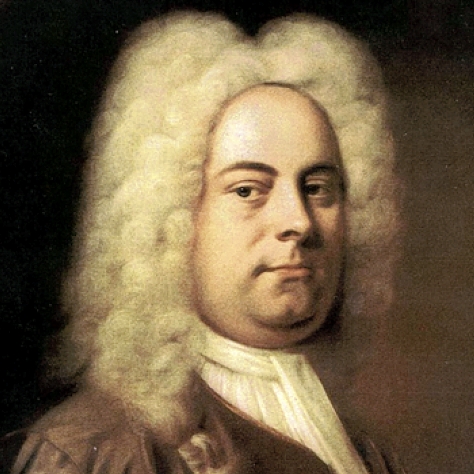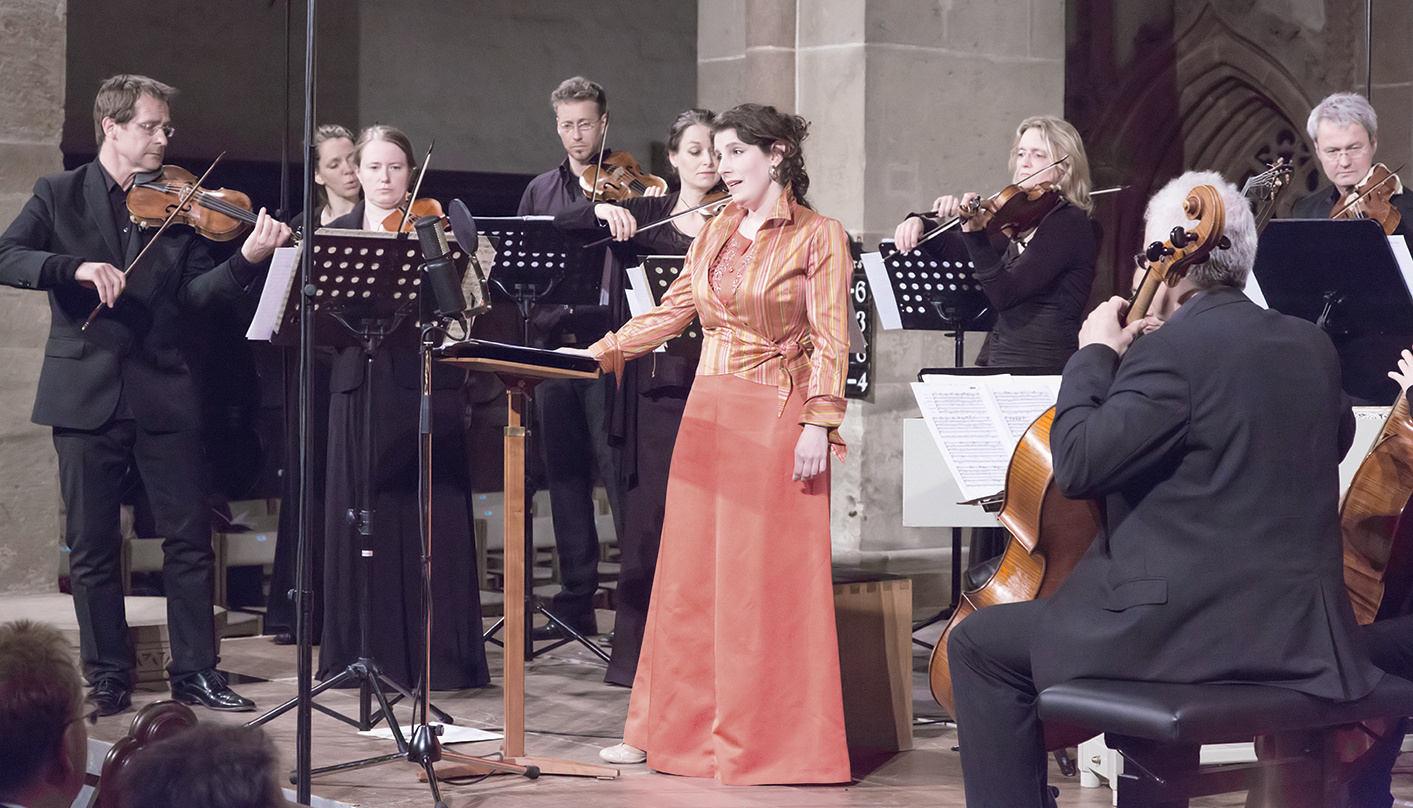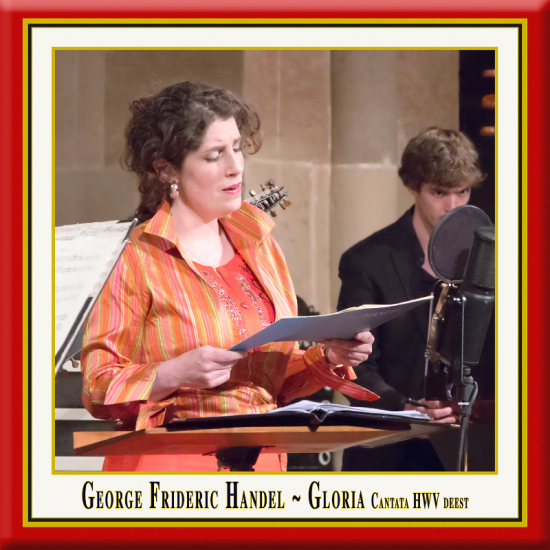HANDEL: Gloria
Track
G L O R I A
The sacred solo cantata for soprano and strings (HWV deest),
performed by Sarah Wegener (Soprano) and the ensemble il capriccio
A live recording from the German
UNESCO World Heritage Site Maulbronn Monastery
HD Recording · DDD · Duration: 15 Min. 22 Sec.
Digital Album · 6 Tracks
MP3 Album
320 kBit/sec.



G
eorge Frideric Handel's Gloria is a sacred solo cantata, a setting of the Gloria, the liturgical part of the Mass, for soprano and strings. Handel may have composed it in Germany before departing for Italy in 1706. The composition was lost and was only attributed to Handel in 2001. Gloria (HWV deest, the Latin word meaning "missing"), is a work which was missing from the Handel thematic catalog, but was discovered at the Royal Academy of Music's library in 2001. Handel may have composed Gloria, a demanding piece for a coloratura voice, two violins and basso continuo, during his early years in Germany prior to his departure for Italy in 1706 or in Italy in 1707. He divided the liturgical text in eight movements. Later he used parts of it for his compositions Laudate pueri dominum and Utrecht Jubilate. The manuscript is not in Handel's hand but bound in a collection of arias by Handel. The singer William Savage (1720-1789) owned the volume. Probably his pupil Robert Stevens left it to the Academy upon his death in 1837. The work was identified by Hans Joachim Marx, professor of the University of Hamburg. A note in the Sunday Telegraph on 11 March 2001 announced "Lost work by Handel could rival Messiah / An unknown choral work by Handel that some music scholars believe will come to be regarded as significant as Messiah has been discovered in the library of the Royal Academy of Music", but that was a sensational heading, whereas the article described the work correctly. "Perhaps not too many sopranos will be able to perform this piece.", was a comment of Marx, who had found the manuscript. Curtis Price, the principal of the Academy, testified: "The music is fresh, exuberant and a little wild in places, but unmistakably Handel." It was then believed that the piece was written in Italy in 1707. Emma Kirkby, who performed the first recording, released in May 2001, said that "the piece has individuality and charm, good bravura moments, and, more important, some moments of depth, beauty, and poignancy". The first public performance was on 18 May 2001, sung by soprano Patrizia Kwella with Fiori Musicali and Penelope Rapson as artistic director, at the Hinchingbrooke Performing Arts Centre in Huntingdon. A second performance was given at the International Händel Göttingen Festival on 3 June 2001 by Dominique Labelle with the Philharmonia Baroque Orchestra and Nicholas McGegan. Katia Plaschka performed it in 2003 in the Unionskirche, Idstein, along with Handel's Utrecht Te Deum and Jubilate.
From Wikipedia, the free encyclopedia
S
arah Wegener enthrals listeners with the richness and warmth of her voice and approaches every role in a chamber musical way. She regularly works with Kent Nagano, Philippe Herreweghe, Thomas Hengelbrock, Heinz Holliger, Michael Hofstetter and Frieder Bernius. Concerts have taken her to the Schleswig-Holstein Musik Festival, Rheingau Music Festival, Konzerthaus Berlin, Tonhalle Zürich, Wiener Konzerthaus, Concertgebouw Amsterdam, Casa da Música Porto and to the Bozar Brussels. The British-German soprano studied singing with Prof. Jaeger-Böhm in Stuttgart and took part in masterclasses with Dame Gwyneth Jones and Renée Morloc. She has formed a close artistic relationship with the composer Georg Friedrich Haas. She was nominated for 'Singer of the Year' by Opernwelt magazine in 2011 for her interpretation of the main role of Nadja in his opera Bluthaus, which she performed at the Schwetzinger SWR Festival, Wiener Festwochen and Staatstheater Saarbrücken. In the 2015/16 season she made her debuts at the Royal Opera House London and Deutsche Oper Berlin in his new opera Morgen und Abend. In 2014 she was also highly praised for the world premiere of Jörg Widmann's Labyrinth III at the Kölner Philharmonie with the WDR Symphony Orchestra under Emilio Pomàrico. Her repertoire includes Handel's Messiah, Mozart's Mass in C minor, Schumann's Faust Scenes, Dvorak's Stabat Mater and Strauss' Four Last Songs. Furthermore, she enjoys frequent performances with the Deutsche Kammerphilharmonie Bremen, Kristiansand Symphony Orchestra, Orchestre des Champs-Élysées/Collegium Vocale Gent, NDR Symphony Orchestra, Orchestre Symphonique de Montréal, Philharmonisches Staatsorchester Hamburg, Kammerorchester Basel and Radio Filharmonisch Orkest. Her discography comprises recordings with Frieder Bernius of arias by Justin Heinrich Knecht (Carus), Korngold's Die stumme Serenade (CPO) and Schubert's Lazarus (Carus), as well as Rossini's Petite Messe solennelle under Tonu Kaljuste (Carus), a CD with the Stuttgart Radio Symphony Orchestra under Heinz Holliger (Hänssler Classic) and a release of Handel's Israel in Egypt with the Maulbronn Chamber Choir under Jürgen Budday (K&K Verlagsanstalt).
F
ounded in 1999, the ensemble il capriccio evolved into a personally, stylistically and musically very individual ensemble. Its members, meeting up from all over middle Europe for mutual working sessions are outstanding musicians of international ensembles and professional orchestras or teachers at a conservatory. All musicians of Il Capriccio have intensively occupied themselves since their studies with historically informed performance. The usage of original instruments only constitutes the sounding foundation for an extremely meaningful and vivid way of musical interacting on stage. Il Capriccio gives concerts in variable instrumentation from the size of a baroque orchestra to the classical string quartet consisting of the principals of the ensemble. The solo part for violin plays the art director Friedemann Wezel. Additionally, Il Capriccio cooperates with important artists such as Sergio Azzolini (bassoon) or Markus Brönnimann (flute). A further and exceptional obligation considering the educational support of young artists was accepted by the 2004 founding of the "Il Capriccio Strings Academy".

Ensemble il capriccio
Violin & Concertmaster: Friedemann Wezel
Violin I: Marieke Bouche, Steffen Hamm, Christine Trinks
Violin II: Dietlind Mayer, Smadar Schidlowsky, Konstanze Winkelmann
Viola: David Dieterle, Johannes Platz · Cello: Juris Teichmanis, Judith Wagner
Double Bass: Kit Scotney · Harpsichord: Evelyn Laib · Lute: Toshinori Ozaki
P
ublishing Authentic Classical Concerts entails for us capturing and recording outstanding performances and concerts for posterity. The performers, audience, opus and room enter into an intimate dialogue that in its form and expression, its atmosphere, is unique and unrepeatable. It is our aim, the philosophy of our house, to enable the listener to acutely experience every facet of this symbiosis, the intensity of the performance, so we record the concerts in direct 2-Track Stereo digital HD. The results are unparalleled interpretations of musical and literary works, simply - audiophile snapshots of permanent value. Flourishing culture, enthralling the audience and last but not least also you the listener, are the values we endeavor to document in our editions and series.
The concerts at the UNESCO World Heritage Maulbronn Monastery supply the ideal conditions for our aspirations. It is, above all, the atmosphere of the romantic, candle-lit arches, the magic of the monastery in its unadulterated sublime presence and tranquillity that impresses itself upon the performers and audience of these concerts. Renowned soloists and ensembles from the international arena repeatedly welcome the opportunity to appear here - enjoying the unparalleled acoustic and architectural beauty of this World Heritage Site, providing exquisite performances of secular and sacred music, documented by us in our Maulbronn Monastery Edition.
Andreas Otto Grimminger & Josef-Stefan Kindler, K&K Verlagsanstalt
I. Gloria in excelsis Deo.
II. Et in terra pax hominibus bonae voluntatis.
III. Laudamus te. Benedicimus te.
Adoramus te. Glorificamus te.
Gratias agimus tibi
propter magnam gloriam tuam.
IV. Domine Deus, Rex coelestis,
Deus Pater omnipotens.
Domine Fili unigenite, Iesu Christe.
Domine Deus, Agnus Dei, Filius Patris.
V. Qui tollis peccata mundi, miserere nobis.
Qui tollis peccata mundi,
suscipe deprecationem nostram.
Qui sedes ad dexteram Patris, miserere nobis.
VI. Quoniam tu solus Sanctus.
Tu solus Dominus.
Tu solus Altissimus, Iesu Christe.
Con Sancto Spiritu, in gloria Dei Patris.
Amen




